Fishing Species
Fish Species of Sandy Pointe Lake
The developers at Sandy Pointe took pride in creating a multi-use lake, from water sports to great fishing opportunities. To protect the lake's ecosystem and maintain a healthy fish population, the board takes significant steps to prevent invasive species from entering the lake. Beneath the water's surface lies a diverse array of fish and other aquatic animals.
CATFISH:
These are the most common varieties of catfish in Sandy Pointe Lake. Larger catfish help control the shad populations, so Sandy Pointe permits keeping only two catfish under 21 inches per day per household. Catfish can be caught with bottom-rigged worms, prepared stink baits, live minnows, or sometimes with artificial lures while targeting other species. They are found throughout the lake, so fishing from your dock often yields catches.
- A bluish-silver fish without dark spots, scaleless, with an adipose fin, and eight barbels for locating food. Its deeply forked tail and straight-edged anal fin with more than 30 rays are distinctive. Be cautious of the hard spines on its dorsal and pectoral fins, which can puncture skin if mishandled. Primarily feeds near or on the bottom.

- Channel Cat: Olive-brown or slate-blue with dark spots, especially in younger fish. This scaleless fish has a rounded anal fin with 24-29 rays. Breeding males may turn dark blue, often confused with blue catfish. Like blue cats, channel cats have hard spines on the dorsal and pectoral fins, so handle carefully. They are bottom feeders, consuming both live and dead organisms. Among the top five sport fish in the state.

- Flathead Cat: Less common in Sandy Pointe, the flathead has a broad, flat head with a projecting lower jaw and squarish tail fin. Its color ranges from pale yellow to light brown, sometimes mottled if from clear water. Also has hard dorsal and pectoral fin spines to be cautious of.

BASS:
Sandy Pointe Lake is home to two bass varieties, considered prime sport fish and vital for controlling shad populations. Due to their importance, bass are "catch and release" only. Bass can be caught using artificial lures, worms, or minnows. Fishing around structures like docks, rock edges, or brush increases the chances of success.
Largemouth Bass: A torpedo-shaped predator with an upper jaw extending past the eye. Typically, it has a broad, continuous stripe along its side. Prefers warm, clear waters with minimal current and feeds on small crustaceans, insects, fish, crayfish, and large insects. The largemouth population in Sandy Pointe is healthy, with many fish weighing 3 to 5 lbs, and some have been caught and released over 8 lbs.

Smallmouth Bass: Though less common, Sandy Pointe has a small population of smallmouths. Recognized for their fighting ability, smallmouths are bronze-colored with vertical bars. The best areas to catch them are along the rocky southern and northern lake edges, using crankbaits or small spinners like a Mepps. Most smallmouth are now in the 12 to 15 inch range since their initial stocking. It is unclear if conditions are right for this species to spawn in our lake, however there have been some reports of smaller smallmouths caught that might indicate some successful spawning.
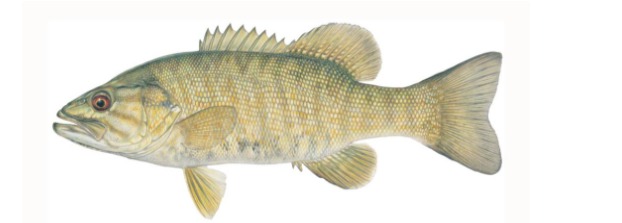
CRAPPIE & BLUEGILL:
Sandy Pointe has a strong population of white and black crappie and bluegill, popular for fish fries. A limit of 10 crappie/bluegill per household per day and a total possession limit of 25 must be observed. If kept crappie must be between 10-13 inches, and bluegill between 6-10 inches to keep; larger specimens must be released as they are excellent egg layers. To catch crappie try a worm or minnow on a bobber at a depth of around 3 feet. A lot of success happens right off docks or on brush piles around the lake. For bluegill use a smaller hook with worm or crickets on a small bobber near the surface. Fish around docks and watch the bluegill dart after the bait from underneath the docks. Fun for kids!!
Black Crappie: Silvery with irregular black speckles. Prefers clear waters and weighs more on average than white crappie. A top-five sport fish.
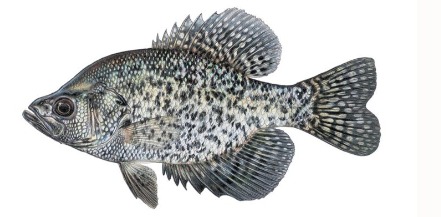
White Crappie: Silvery with faint black bars and becomes darker during spawning. Like black crappie, it can overpopulate if predator populations are low.

Bluegill: A flat fish with a small mouth and a dark spot on the dorsal fin's base. Primarily eats insects and small crustaceans. Bluegill often spawn in shallow, small water areas.

WIPERS:
A hybrid of white and striped bass, wipers have prominent, broken, and unbroken lines along the sides and a distinct double patch on the tongue. Stocked to control shad and white perch, wipers are catch-and-release only. They are vigorous hunters and often feed in packs, putting up a challenging fight for anglers. If you see small fish activity on the lake surface usually that is a sign that a predator fish, like wipers, are underneath feeding on the shad ball. Catching wipers is a little more challenging since they move around the lake in schools and are usually a little deeper than most species. For this a boat with fishing electronics will make catching easier. Once found Wipers will give the angler a tremendous battle. Reports of wipers up to 10lbs have been caught and released at Sandy Pointe.

Say AHHH and look for the double tongue patch to determine if it is a wiper or white bass. A double tongue patch indicates a wiper.
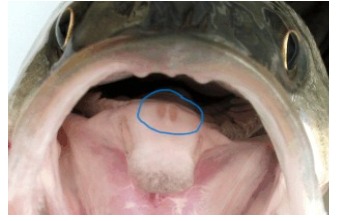
WALLEYE:
Sandy Pointe Lake has a very good population of Walleye. This species has been stocked numerous times over the last few years. It appears that the walleye have adapted well and might be experiencing limited reproduction in our lake. The main purpose for stocking walleye was for the control of shad and white perch. For this reason walleye are catch and release only. To catch walleye try worms or minnows and artificial lures just about anywhere on the lake. Artificial lures such as spinners, Mepps, crank bait divers work well. If you have access to a fishing boat or pontoon a lot of success occurs trolling diver baits early morning or just before sunset when walleye are active feeders close to shore.
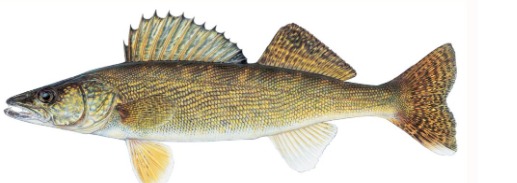
TIGER MUSKY:
This hybrid of northern pike and muskellunge is managed as a trophy fishery and catch-and-release only. With sharp teeth and vertical stripes, tiger muskies grow over 30 inches, offering an exciting challenge. Though rarely targeted, they’re occasionally caught by anglers aiming for other fish.

BAIT FISH:
The lake's bait fish include shiners, minnows, and gizzard shad, which are commonly seen near the water surface. Sandy Pointe has a stable bait fish population, so stocking is not required.
Less Preferred Fish in Sandy Pointe Lake
Certain species are less desirable and can be harvested and removed:
White Perch: These silvery fish are overpopulated and compete for food with preferred species. Anglers are encouraged to remove any white perch they catch. To help identify notice the absence of horizontal broken lines in pic (#1) that are exclusive on wipers and white bass in pic (#2). The White perch will have one horizontal line running through the entire middle of the body. It appears that predatory fish stocking is starting to reduce the numbers of White Perch in our lake.
1. White Perch (remove from lake) 2. Wiper (catch and release)
Gar: Both Longnose and Shortnose gar are primitive, bony fish with sharp teeth. Gar are unwanted in the lake, and archery fishing is a popular method for their removal.
Longnose gar: Shortnose gar:

CARP: All carp, including common and silver varieties, may be removed from the lake. Many anglers target carp with archery in shallow water but can also be caught using corn or worms.
Silver carp: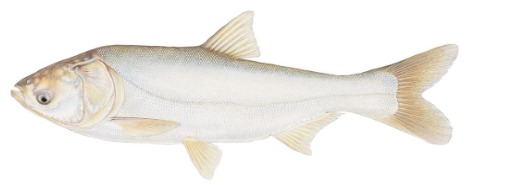
Common Carp:
Sheepshead Drum:
FISHING TIPS:
Popular lure types for Sandy Pointe include spinner baits, soft plastics, blade baits, and jigs. Live bait like nightcrawlers and minnows is effective for most fish, do not dispose of unused minnows back into the lake. Since our lake has a sufficient population of bait fish we do not need to introduce any more or a potentially new variety of minnow that was sold by the bait shop.
Spinner Baits:

Blade Baits:
Soft Plastics:
Crankbaits:

Jigs:
If you have any questions regarding fishing at Sandy Pointe contact the fishing committee by sending an email to [email protected]
In addition you can now donate to the health of our lake with tax-deductible donations. We have created The Sandy Pointe Conservation Association Inc. as a 501(c)(3) organization EIN: 93-2785516. There are two ways to donate to the TSPCA. 1) You can write a check made out THE SANDY POINTE CONSERVATION ASSOCIATION INC and give it to either Roger Johnson or any board member or 2) If you wish to use a credit card you can follow this link: (copy and paste to your web browser) https://gofund.me/94a301f3
Pages
- Home
- Events
- Our community
- About Sandy Pointe
- Meet your neighbors
- Pet Directory
- Sandy Pointe Weather
- Sandy Pointe Wind Forecast
- Boat Ramp Info
- Temp Gate Code
- FAQs
- Fishing Species
- Communications
- Alerts
- Community Facilities
- Lost and Found
- Boater safety
- Boat Traffic Pattern Map
- Lake Topography Depth
- Rules
- Why?
- General
- Boating
- Jet skiing
- Swimming/Kayak
- Fishing
- ATV
- Docks
- Construction
- Construction Rules
- Water Wells
- Architecture styles
- Submit your plans
- Fines and Penalties
- HOA
- Board members
- Meeting minutes
- Financials
- Other Documents / Reports
- Corporate Documents
- Tap Water Reports
- Lake Water Reports
- Contact us
- Fishing Committee
- News - Fishing Committee
- Fishing Committee Minutes
- Businesses and Services
- Vendor contacts
- Community members businesses

